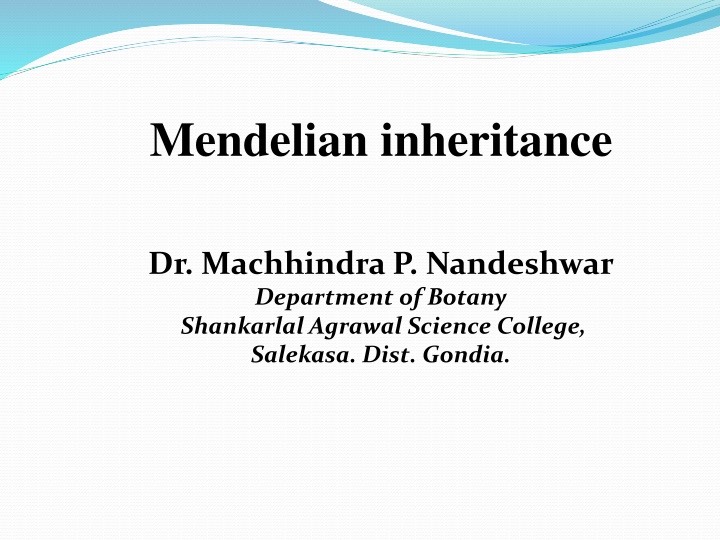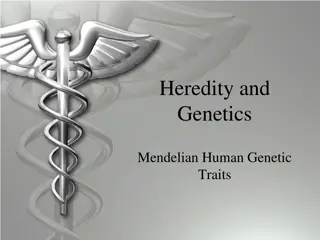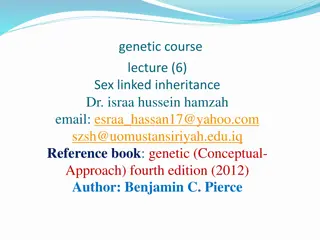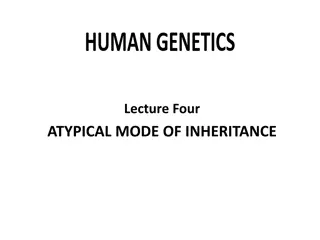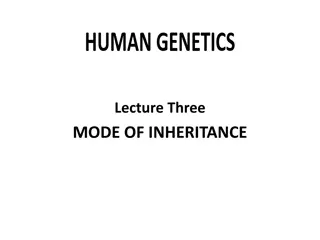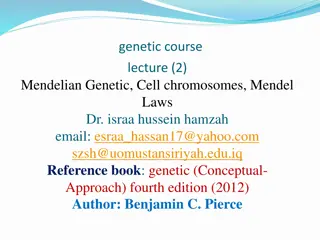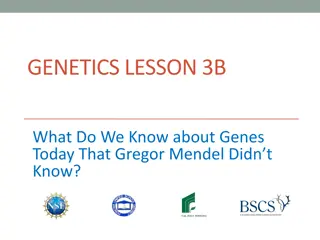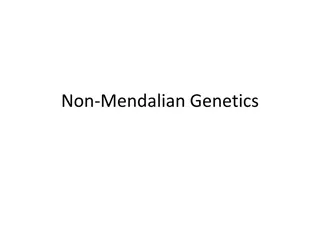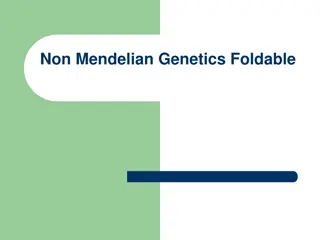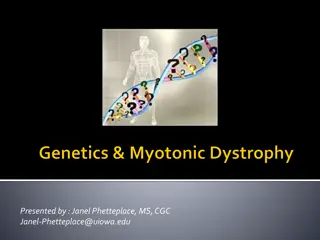Mendelian Inheritance: History and Laws
The laws of inheritance attributed to Gregor Mendel were derived from his groundbreaking hybridization experiments on garden peas in the 19th century. Mendel's principles of heredity laid the foundation for modern genetics, revolutionizing our understanding of genetic inheritance.
Download Presentation

Please find below an Image/Link to download the presentation.
The content on the website is provided AS IS for your information and personal use only. It may not be sold, licensed, or shared on other websites without obtaining consent from the author.If you encounter any issues during the download, it is possible that the publisher has removed the file from their server.
You are allowed to download the files provided on this website for personal or commercial use, subject to the condition that they are used lawfully. All files are the property of their respective owners.
The content on the website is provided AS IS for your information and personal use only. It may not be sold, licensed, or shared on other websites without obtaining consent from the author.
E N D
Presentation Transcript
Mendelian inheritance Dr. Machhindra P. Nandeshwar Department of Botany Shankarlal Agrawal Science College, Salekasa. Dist. Gondia.
https://upload.wikimedia.org/wikipedia/commons/thumb/d/d3/Gregor_Mendel.png/250px-Gregor_Mendel.pnghttps://upload.wikimedia.org/wikipedia/commons/thumb/d/d3/Gregor_Mendel.png/250px-Gregor_Mendel.png Gregor Mendel, the German-speaking Augustinian monk who founded the modern science of genetics.
History The laws of inheritance were derived by Gregor Mendel, a nineteenth-century conducting hybridization experiments on (Pisum sativum) garden peas, he planted in the backyard of the church Between 1856 and 1863, he cultivated and tested some 5,000 pea plants. From these experiments, he induced two generalizations which later became known as Mendel's Principles of Heredity or Mendelian inheritance. A major block to understanding their significance was the importance attached by 19th-century biologists to the apparent blending of inherited traits in the overall appearance of the progeny, now known to be due to multigene interactions, in contrast to the organ-specific binary characters studied by Mendel.
Re-discovery In 1900, however, his work was "re-discovered" by three European scientists, Hugo de Vries, Carl Correns, and Erich von Tschermak. The exact nature of the "re-discovery" has been somewhat debated. De Vries published first on the subject, mentioning Mendel in a footnote, while Correns pointed out Mendel's priority after having read De Vries' paper and realizing that he himself did not have priority. De Vries may not have acknowledged truthfully how much of his knowledge of the laws came from his own work, or came only after reading Mendel's paper. Later scholars have accused Von Tschermak of not truly understanding the results at all. Regardless, the "re-discovery" made Mendelism an important but controversial theory. Its most vigorous promoter in Europe was William Bateson, who coined the terms "genetics" and "allele" to describe many of its tenets.
Mendels Laws: 1. Law of Segregations (1st Law): 2. Law of Independent Assortment (2nd Law): 3. Law of Dominance (3rd Law):
1. Mendels 1st Law: Law of Segregation P1 During gamete formation, the alleles for each gene segregate from each Tall pea plant Short pea plant other so that each gamete carries F1 only one allele for each gene. All tall pea plants F2 3 tall: 1 short
Law of Segregation https://upload.wikimedia.org/wikipedia/commons/thumb/f/fe/Mendelian_inheritance.svg/230px-Mendelian_inheritance.svg.png Dominant (red) and recessive (white) phenotype look alike in the F1 (first) generation and show a 3:1 ratio in the F2 (second) generation.
2. Mendels 2nd Law: Law of Independent assortment Genes for different traits can segregate independently during the formation of gametes.
Law of Independent assortment Figure Dihybrid cross. The phenotypes of two independent traits show a 9:3:3:1 ratio in the F2 generation. In this example, coat color is indicated by B (brown, dominant) or b (white), while tail length is indicated by S (short, dominant) or s (long). https://upload.wikimedia.org/wikipedia/commons/thumb/3/3a/Dihybrid_cross.svg/280px-Dihybrid_cross.svg.png When parents are homozygous for each trait (SSbb and ssBB), their children in the F1 generation are heterozygous at both loci and only show the dominant phenotypes (SsbB). If the children mate with each other, in the F2 generation all combinations of coat color and tail length occur: 9 are brown/short (purple boxes), 3 are white/short (pink boxes), 3 are brown/long (blue boxes) and 1 is white/long (green box).
3. Mendels 3rd Law: Law of Dominance Tall plant Short plant Some alleles are dominant while others are recessive; an organism with at least one dominant allele T T T T t t t t will display the effect of the T T t t dominant allele. F1 F1 All tall plants t t T T
Law of Dominance Mendel's Law of Dominance states that recessive alleles will always be masked by dominant alleles. Therefore, a cross https://upload.wikimedia.org/wikipedia/commons/thumb/1/17/Punnett_square_mendel_flowers.svg/250px-Punnett_square_mendel_flowers.svg.png between a homozygous dominant and a homozygous recessive will always express the dominant phenotype, while still having a heterozygous genotype.
Incomplete Dominance The F1 offspring of Mendel's pea crosses always looked like one of the two parental varieties. In this situation of "complete dominance," the dominant allele had the same phenotypic effect whether present in one or two copies. But for some characteristics, the F1 hybrids have an appearance in between the phenotypes of the two parental varieties. A cross between two four o'clock (Mirabilis jalapa) plants shows this common exception to Mendel's principles. Some alleles are neither dominant nor recessive. The F1 generation produced by a cross between red-flowered (RR) and white flowered (WW) Mirabilis jalapa plants consists of pink-colored flowers (RW). This third phenotype results from flowers of the heterzygote having less red pigment than the red homozygotes. Cases in which one allele is not completely dominant over another are called incomplete dominance. In incomplete dominance, the heterozygous phenotype lies somewhere between the two homozygous phenotypes. In incomplete dominance, the heterozygous phenotype lies somewhere between the two homozygous phenotypes.
Incomplete dominance This Punnett square illustrates incomplete dominance. In this example, the red petal trait https://upload.wikimedia.org/wikipedia/commons/thumb/8/8c/Incomplete_dominance.svg/220px-Incomplete_dominance.svg.png associated with the R allele blends with the white petal trait of the r allele so that plants with the Rr genotype have pink flowers.
Non-Mendelian inheritance In four o'clock plants, the alleles for red and white flowers show incomplete dominance. https://upload.wikimedia.org/wikipedia/commons/thumb/8/82/Mendelian_inheritance_1_2_1.png/230px-Mendelian_inheritance_1_2_1.png As seen in the F1 generation, heterozygous (wr) plants have "pink" flowers a mix of "red" (rr) and "white" (ww) coloring. The F2 generation shows a 1:2:1 ratio of red:pink:white
Co-dominance occurs when the contributions of both alleles are visible in the phenotype. A similar situation arises from codominance, in which the phenotypes produced by both alleles are clearly expressed. https://upload.wikimedia.org/wikipedia/commons/thumb/f/f3/Co-dominance_Rhododendron.jpg/220px-Co-dominance_Rhododendron.jpg
Co-dominance https://upload.wikimedia.org/wikipedia/commons/thumb/8/88/Co-dominance_in_Roan_Cattle.svg/220px-Co-dominance_in_Roan_Cattle.svg.png This diagram shows co-dominance. In this example a white bull (WW) mates with a red cow (RR), and their offspring exhibit co-dominance expressing both white and red hairs.
